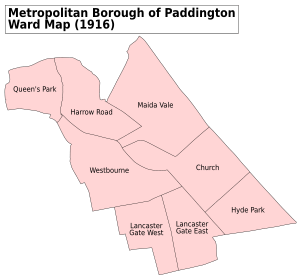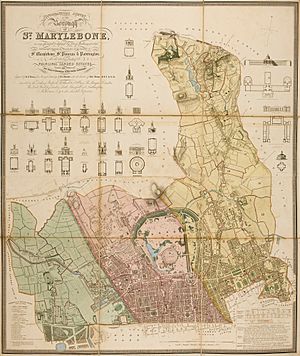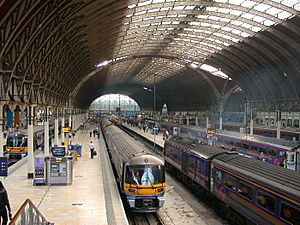Paddington facts for kids
Quick facts for kids Paddington |
|
|---|---|
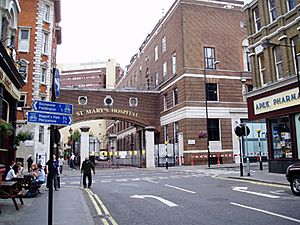 St Mary's Hospital |
|
| OS grid reference | TQ267814 |
| London borough | |
| Ceremonial county | Greater London |
| Region | |
| Country | England |
| Sovereign state | United Kingdom |
| Post town | LONDON |
| Postcode district | W2, W9 |
| Dialling code | 020 |
| Police | Metropolitan |
| Fire | London |
| Ambulance | London |
| EU Parliament | London |
| UK Parliament |
|
| London Assembly | |
Paddington is a lively area in central London, England. It's part of the City of Westminster. This famous place is known for its busy Paddington train station. The station was designed by the brilliant engineer Isambard Kingdom Brunel.
Paddington is also home to St Mary's Hospital. You might know it as the place where Paddington Bear was found in the popular children's books! The area is always changing, with new projects like Paddington Waterside bringing modern buildings and spaces.
Nearby districts include Maida Vale, Westbourne, and Bayswater.
Contents
- Discovering Paddington's Past
- Paddington's Location
- How Paddington is Governed
- Famous Places in Paddington
- Getting Around Paddington
- Modern Developments in Paddington
- Places of Worship
- Famous People from Paddington
- Notable Residents from the Past
- Paddington in Books and Movies
- Images for kids
- See also
Discovering Paddington's Past
Paddington has a long history, going back to medieval times. It was once a small village in Middlesex. The first mentions of "Padington" might be from the 10th century. These old documents talk about land given to monks by King Edgar.
However, these papers might have been created much later, after the Normans took over in 1066. Paddington isn't even mentioned in the famous Domesday Book from 1086. Experts believe a Saxon village might have been located where old Roman roads crossed. These roads are now Edgware Road and Harrow and Uxbridge Roads.
In the 16th century, during the Elizabethan and early Stuart times, a family called Small lived in the main manor house. Nicholas Small was a cloth maker. His wife, Jane Small, even had her portrait painted by the famous artist Holbein.
As London grew, Paddington became more connected to the city. By 1773, people saw it as one of the "ancient villages" that London was starting to include.
Tyburnia: A Grand Neighborhood
In the 1800s, a part of Paddington became known as Tyburnia. This area was meant to be a fancy residential district, similar to Belgravia. It was planned with large squares and beautiful cream-colored houses.
Even though the plans weren't fully finished, Tyburnia became a very respected and elegant place to live. The writer Thackeray even called it "the most respectable district of the habitable globe."
What Does "Paddington" Mean?
The exact meaning of the name "Paddington" is a bit of a mystery! There are a few ideas:
- Padre-ing-tun: Meaning "father's meadow village."
- Pad-ing-tun: Meaning "pack-horse meadow village."
- Pæding-tun: Meaning "village of the race of Pæd." This last idea comes from a Victorian scholar named John Mitchell Kemble.
There's another place called Paddington in Surrey, which might be linked to the same old family.
Paddington's Location
Paddington is centered around the famous Paddington railway station. The area is smaller than the old parish boundaries.
To the north, it's separated from Maida Vale by the Regent's Canal. Where they meet, you'll find the charming area of Little Venice. To the east, Edgware Road divides Paddington from Marylebone. To the southwest, you'll find Bayswater.
How Paddington is Governed
Paddington used to be its own borough called the Metropolitan Borough of Paddington. Its main office was at the Paddington Town Hall. But in 1965, Paddington became part of the larger City of Westminster.
Famous Places in Paddington
Browning's Pool
This is a lovely lagoon created in the 1810s. It's where the Paddington Arm of the Grand Union Canal, the Regent's Canal, and the Paddington Basin all meet. It's a key part of the Little Venice area.
It's said to be named after the poet Robert Browning. It's also called the "Little Venice Lagoon" and has a small island known as Browning's Island. While Browning is often credited with the name "Little Venice," some believe Lord Byron actually came up with it.
London Paddington Station
Paddington station is the most famous landmark in the area. Inside the station, you can see statues of its designer, Isambard Kingdom Brunel, and of course, Paddington Bear!
Paddington Basin
The Paddington Basin is where the Paddington Arm of the Grand Union Canal ends. This area has been completely redeveloped. It now has modern offices, homes, shops, and places for fun.
The redeveloped basin has some cool features:
- Heatherwick's Rolling Bridge: A unique bridge that rolls up to let boats pass.
- The Merchant Square Fan Bridge.
- The Floating Pocket Park.
Paddington Central
This is a modern complex built on what used to be railway land. It's north of the station and has places for health, fun, shopping, and eating. The public area near the canal has an amphitheater for events.
Paddington Green
Paddington Green is a green space and a historic area in the east of Paddington. It's home to St Mary on Paddington Green Church. The City of Westminster College also has a campus next to the Green.
Getting Around Paddington
Paddington is a major transport hub. You can get around by train, tube, bus, or even by bike or canal boat!
Trains and Tube
Paddington station is a big station for both London Underground (the Tube) and National Rail trains.
National Rail Services
Great Western Railway trains from Paddington go to places like Reading, Oxford, Bristol, and Cardiff.
The Elizabeth line also runs from Paddington. These trains connect Paddington to destinations in west London and Berkshire. They also go through central and eastern London.
You can also catch trains to Heathrow Airport from Paddington. Both the Elizabeth line and the Heathrow Express go there.
London Underground (Tube)
There are two Tube stations within the Paddington complex:
- The station on Praed Street serves the Bakerloo, Circle, and District lines. These connect Paddington to many central and west London spots like Baker Street and Victoria.
- The station near the Paddington Basin serves the Circle and Hammersmith & City lines. These go west towards Hammersmith and east towards King's Cross and Liverpool Street.
Lancaster Gate tube station is also in the area, served by the Central line.
Paddington Station's History
Paddington station was designed by the famous engineer Isambard Kingdom Brunel. The main building opened in 1854.
The beloved character Paddington Bear was named after the station. In Michael Bond's 1958 book, the Brown family finds Paddington at the station after he arrives from "darkest Peru."
Buses
Many London Buses routes serve Paddington station, including routes 7, 23, 27, 36, 46, 205, and 332. Some buses, like 23, 27, and 36, run 24 hours a day.
Routes 94 and 148 serve Lancaster Gate station, south of Paddington. These also run 24 hours a day.
Roads
Several important roads pass through Paddington:
- The A40 (Westway/Marylebone Flyover) goes west towards Oxford and Birmingham.
- The A402 (Bayswater Road) goes east towards Marble Arch and Oxford Street, and west towards Notting Hill.
- The A404 (Harrow Road) goes northeast towards Wembley and Harrow.
- The A5 (Edgware Road) goes south to Marble Arch and north to Hendon and Edgware. It's part of the London Inner Ring Road.
Cycling
Paddington has good cycling paths from Transport for London (TfL) and the Canal & River Trust.
- Cycle Superhighway 3 (CS3) starts near Paddington and goes through Hyde Park to South Kensington. It continues east to places like Canary Wharf.
- Quietway 2 (Q2) uses traffic-free paths or quiet streets.
- Grand Union Canal towpath and Regent's Canal towpath offer direct, traffic-free routes for cyclists.
You can also find Santander Cycles docking stations in Paddington to rent bikes.
Canals
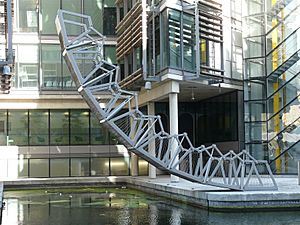
The Paddington Arm of the Grand Union Canal runs from Paddington to Hayes. The Paddington Basin is here, as is Little Venice. A towpath runs along the canal, perfect for walks or bike rides.
The amazing The Rolling Bridge at Paddington Basin was designed by Thomas Heatherwick. He wanted a bridge that would "get out of the way" in a cool, coiling way, inspired by the moving dinosaurs in the movie Jurassic Park!
The Regent's Canal starts at Little Venice and heads east towards Regent's Park, Camden Town, and King's Cross.
Modern Developments in Paddington
For many years, the land around the canals and railways was not used much. But in 1998, the Paddington Waterside Partnership was formed. Their goal was to bring new life to the area.
This has led to big changes, especially around the old railway yards (now called Paddington Central) and the canal (Paddington Basin). Many of these new buildings and facilities are now complete and in use.
There are also plans for more new developments, like at St. Mary's Hospital and Paddington Square. The opening of the Elizabeth line has also brought more people and activity to the area.
Places of Worship
Paddington has several Anglican churches, including St James's, St Mary Magdalene, and St Peter's. There is also a large Muslim community in the area.
Famous People from Paddington
- Kriss Akabusi, athlete
- Robert Baden-Powell, founder of the Scout Movement
- Joe Cole, professional footballer
- Joan Collins, actress
- Elvis Costello, pop musician
- Paul Eddington, actor
- Les Ferdinand, professional footballer
- Andy Fraser, songwriter and bass guitarist
- Alan Johnson, politician
- Patrick Macnee, actor
- Alfred Molina, actor
- Hermione Norris, actress
- George Osborne, politician
- Seal, pop musician
- David Suchet, actor
- John Suchet, newsreader
- Kiefer Sutherland, actor
- Emma Thompson, actress
- Alan Turing, mathematician and computer pioneer
Notable Residents from the Past
Many interesting people have lived in Paddington over the years:
- The famous actress Sarah Siddons lived here in the early 1800s. She is buried at Paddington Green.
- Prince Louis Lucien Bonaparte, a nephew of Napoleon, lived in Norfolk Terrace. He was a linguist who studied different languages.
- The Victorian poet Robert Browning lived in Beauchamp Lodge. He is often said to have named the area "Little Venice" because of its canals. However, some historians believe Lord Byron actually came up with the name.
- Edward Adrian Wilson, a doctor and naturalist, practiced medicine in Paddington. He later died on Captain Robert Scott's Antarctic expedition. A local school was named after him.
- British painter Lucian Freud had his art studio in Paddington for many years.
Paddington in Books and Movies
- Timothy Forsyte, a character in John Galsworthy's The Forsyte Saga, lived in Bayswater Road.
- Most famously, Paddington Bear, from "deepest, darkest Peru", arrived in England at Paddington station.
Images for kids
See also
 In Spanish: Paddington para niños
In Spanish: Paddington para niños



